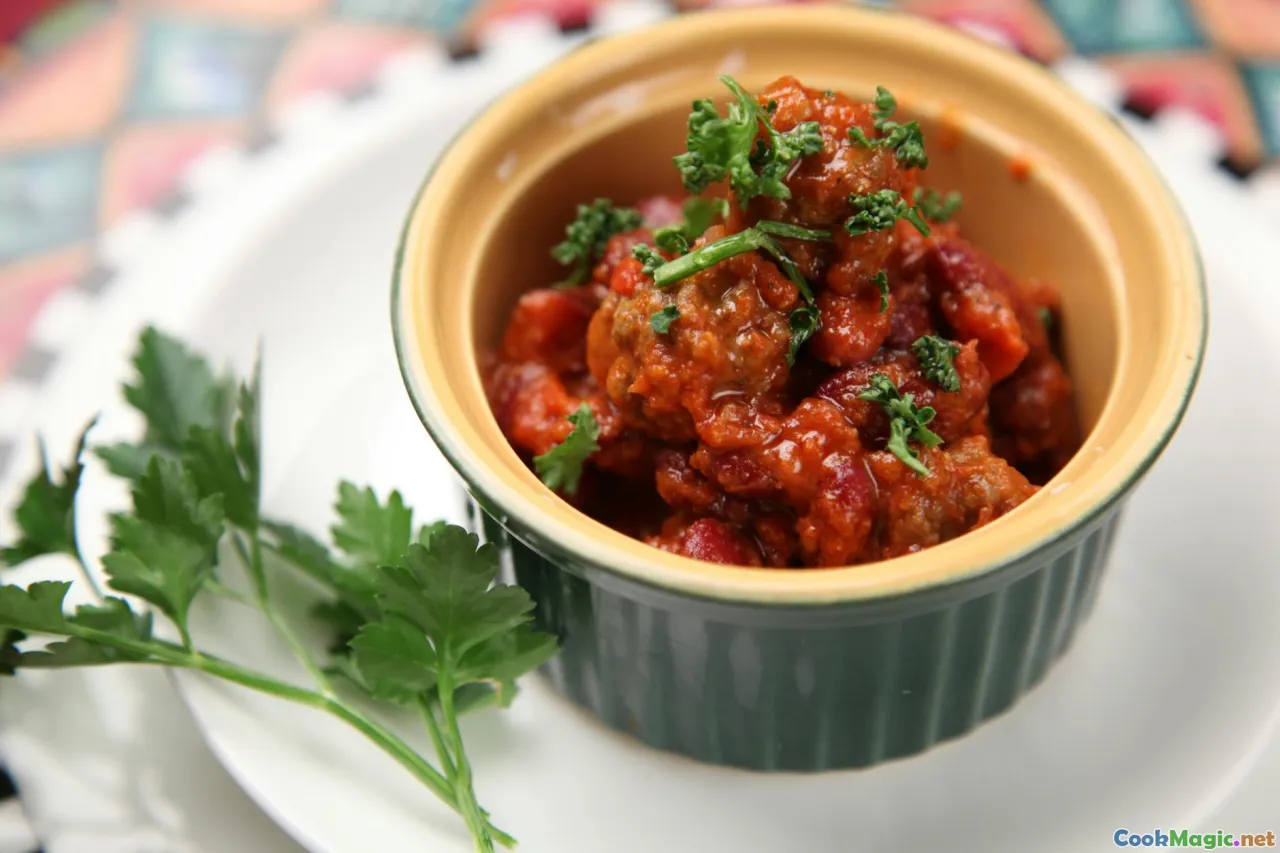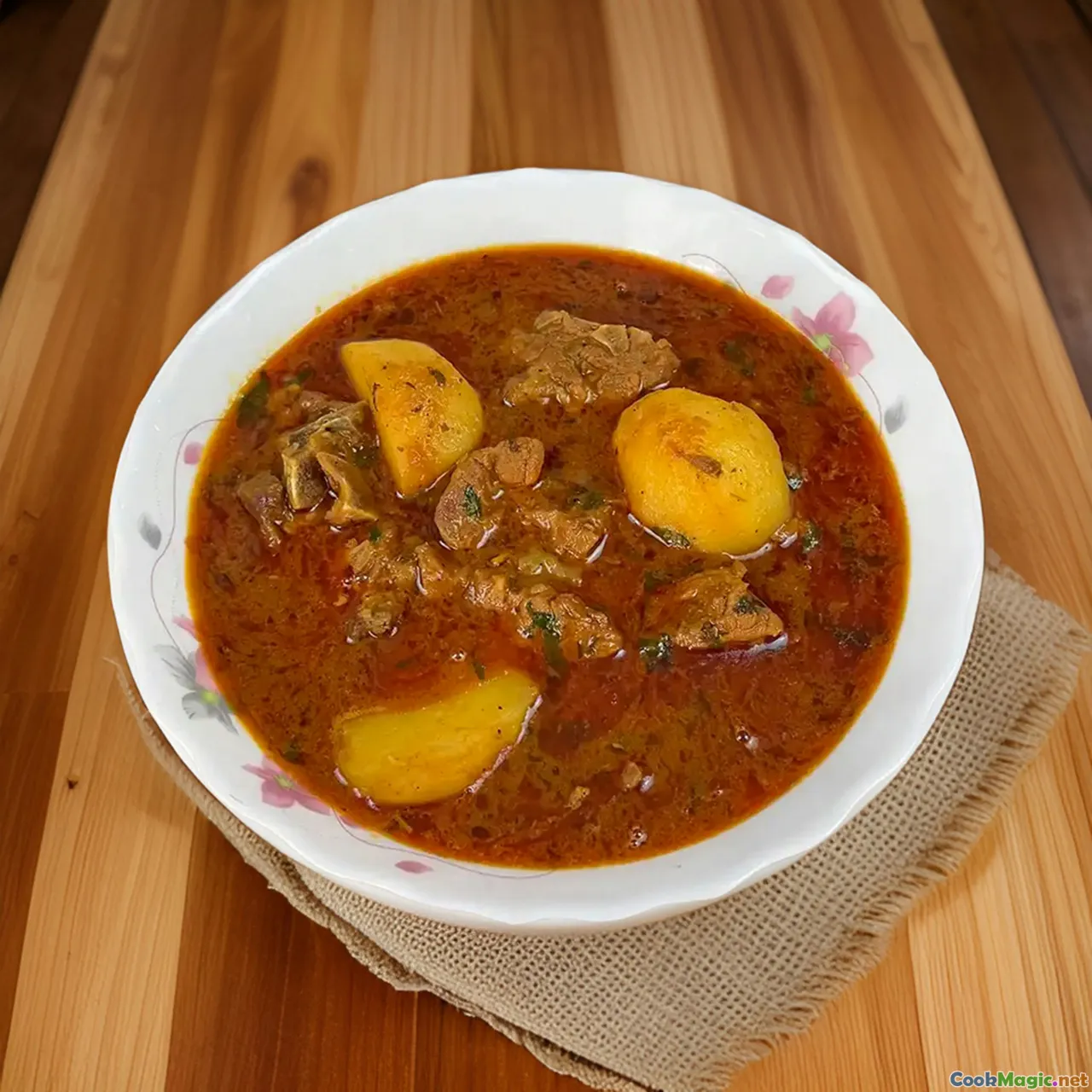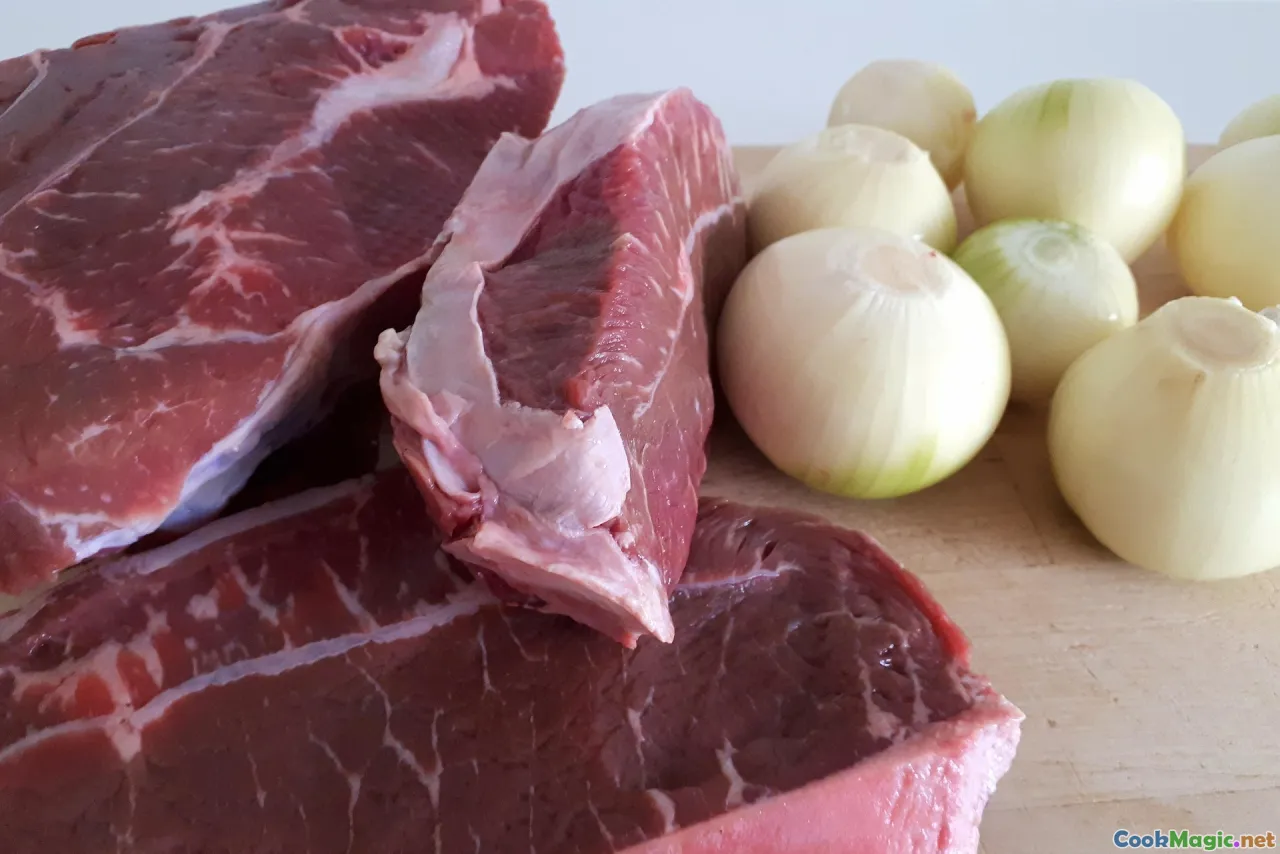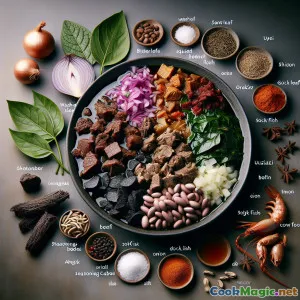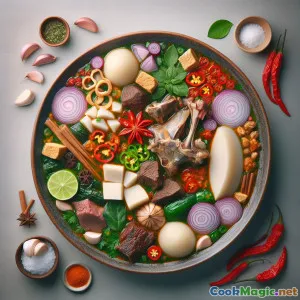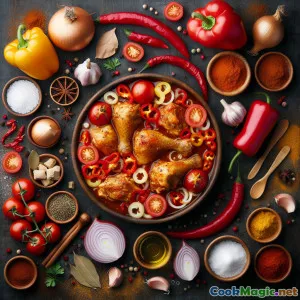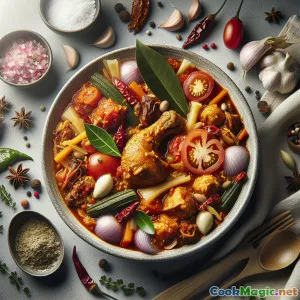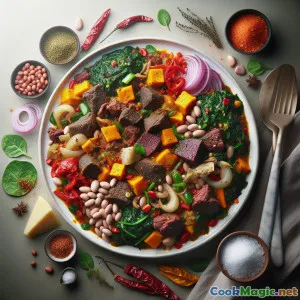
Mélange d'Egusi et de viande de chèvre
(Egusi and Goat Meat Medley)
(0 Avis)0
175
octobre 24, 2025
Signaler un problème
Ingrédients
-
900 grams Viande de chèvre, morceaux avec os
(Rinse and pat dry; shoulder or rib cuts work well)
-
250 grams Egusi (graines de melon), moulues
(Moulu fraîchement pour le meilleur arôme)
-
120 ml huile de palme rouge non raffinée
(Adds signature color and flavor)
-
1500 ml Bouillon non salé (chèvre ou bœuf)
(Homemade preferred; adjust salt if using salted stock)
-
1 large Oignon haché, à utiliser en portions séparées.
(Half for base, half for egusi paste)
-
2 pieces Piments Scotch bonnet ou habanero
(Adjust to heat tolerance)
-
1 large Poivron rouge
(For body and sweetness; blend)
-
30 grams Écrevisse (moulue)
(Traditional umami depth)
-
10 grams Haricots fermentés (iru/dawadawa), rincés
(Fermented; intensifies savory notes)
-
100 grams Poisson fumé séché, émietté en flocons (stockfish ou poisson-chat)
(Adds smoky complexity)
-
250 grams Épinards ou ugwu (feuilles de courge flûtées), hachés
(Fresh or frozen; squeeze excess water if frozen)
-
30 grams Feuille amère (lavée)
(Rinsed to reduce bitterness)
-
3 cloves Ail (haché)
(For goat marinade)
-
20 grams Gingembre frais, râpé
(For goat marinade)
-
1 tsp Thym séché
(Aromatic note for goat marinade)
-
2 leaves Feuilles de laurier
(Mijoter avec du bouillon)
-
2 cubes Cubes de Saveur
(Use low-sodium if available)
-
9 grams sel de mer fin
(About 1½ tsp; season to taste)
-
2 grams Poivre noir moulu
(About ½ tsp; to taste)
-
500 ml Eau
(As needed to adjust thickness)
(Rinse and pat dry; shoulder or rib cuts work well)
(Moulu fraîchement pour le meilleur arôme)
(Adds signature color and flavor)
(Homemade preferred; adjust salt if using salted stock)
(Half for base, half for egusi paste)
(Adjust to heat tolerance)
(For body and sweetness; blend)
(Traditional umami depth)
(Fermented; intensifies savory notes)
(Adds smoky complexity)
(Fresh or frozen; squeeze excess water if frozen)
(Rinsed to reduce bitterness)
(For goat marinade)
(For goat marinade)
(Aromatic note for goat marinade)
(Mijoter avec du bouillon)
(Use low-sodium if available)
(About 1½ tsp; season to taste)
(About ½ tsp; to taste)
(As needed to adjust thickness)
Nutrition
- Portions: 6
- Taille de portion: 1 bol (350g)
- Calories: 620 kcal
- Carbohydrates: 0 g
- Protein: 36 g
- Fat: 44 g
- Fiber: 4 g
- Sugar: 4 g
- Sodium: 780 mg
- Cholesterol: 110 mg
- Calcium: 140 mg
- Iron: 5.2 mg
Instructions
-
1 - Marinate the Goat:
In a bowl, toss goat meat with garlic, ginger, thyme, a pinch of salt, and black pepper. Set aside while you prepare other elements.
-
2 - Blend the pepper base:
Blend half the onion with scotch bonnet and red bell pepper until smooth. Add crayfish to the blender, pulse to combine, and set aside.
-
3 - Make the egusi paste:
In a separate bowl, mix ground egusi with the remaining chopped onion and 120–180 ml water to form a thick paste that holds a dollop.
-
4 - Brown the goat:
Heat half the palm oil in a heavy pot over medium-high. Brown goat pieces in batches until lightly caramelized. Return all meat to pot.
-
5 - Simmer to tenderness:
Add stock, bay leaves, and seasoning cubes. Bring to a boil, reduce to a simmer, cover, and cook until goat is nearly tender (35–45 minutes).
-
6 - Sauté the flavor base:
In a separate wide pan, warm remaining palm oil. Add locust beans and sauté briefly, then pour in the pepper blend. Cook, stirring, until reduced and glossy.
-
7 - Fry the egusi:
Spoon egusi paste into the sautéed base in small dollops. Let set, then flip and fry until lightly toasted at the edges and aromatic.
-
8 - Combine and thicken:
Transfer the fried egusi mixture into the goat pot. Stir gently. If too thick, loosen with hot stock or water; if too thin, simmer uncovered.
-
9 - Layer in smoked fish and bitter leaf:
Fold in flaked smoked fish and bitter leaf. Simmer a few minutes to meld flavors.
-
10 - Add the greens:
Stir in spinach or ugu. Cook just until wilted and vibrant, 2–3 minutes.
-
11 - Final seasoning:
Taste and adjust salt and pepper. Remove bay leaves. The stew should be savory, nutty, and gently spicy.
-
12 - Rest and Serve:
Let the pot rest 5 minutes off heat. Serve hot with pounded yam, eba, fufu, or steamed rice.
In a bowl, toss goat meat with garlic, ginger, thyme, a pinch of salt, and black pepper. Set aside while you prepare other elements.
Blend half the onion with scotch bonnet and red bell pepper until smooth. Add crayfish to the blender, pulse to combine, and set aside.
In a separate bowl, mix ground egusi with the remaining chopped onion and 120–180 ml water to form a thick paste that holds a dollop.
Heat half the palm oil in a heavy pot over medium-high. Brown goat pieces in batches until lightly caramelized. Return all meat to pot.
Add stock, bay leaves, and seasoning cubes. Bring to a boil, reduce to a simmer, cover, and cook until goat is nearly tender (35–45 minutes).
In a separate wide pan, warm remaining palm oil. Add locust beans and sauté briefly, then pour in the pepper blend. Cook, stirring, until reduced and glossy.
Spoon egusi paste into the sautéed base in small dollops. Let set, then flip and fry until lightly toasted at the edges and aromatic.
Transfer the fried egusi mixture into the goat pot. Stir gently. If too thick, loosen with hot stock or water; if too thin, simmer uncovered.
Fold in flaked smoked fish and bitter leaf. Simmer a few minutes to meld flavors.
Stir in spinach or ugu. Cook just until wilted and vibrant, 2–3 minutes.
Taste and adjust salt and pepper. Remove bay leaves. The stew should be savory, nutty, and gently spicy.
Let the pot rest 5 minutes off heat. Serve hot with pounded yam, eba, fufu, or steamed rice.
En savoir plus sur: Mélange d'Egusi et de viande de chèvre
About Egusi and Goat Meat Medley
Egusi and Goat Meat Medley is a richly layered Nigerian classic that showcases the deep nutty flavor of ground melon seeds (egusi) and the succulent, slightly gamey character of goat. This dish is a study in contrasts: creamy and hearty from the egusi, bright and aromatic from peppers and onions, and irresistibly savory thanks to palm oil, fermented locust beans, and optional smoked fish. It’s the sort of stew that anchors family gatherings, invites conversation, and begs for a traditional pairing like pounded yam, eba, or fufu.
What Makes This Version Special
- Two-pot technique: frying the egusi in a separate pan before combining helps build toasty notes and fluffy “curds,” keeping the stew texturally interesting.
- Balanced heat: scotch bonnet provides warmth without overshadowing the egusi’s nuttiness; the bell pepper adds body and sweetness.
- Layered umami: ground crayfish, locust beans (iru), and smoked fish lend an almost oceanic depth that amplifies the goat’s savoriness.
Ingredient Spotlight
- Egusi: Ground melon seeds that thicken and enrich the stew. When fried properly, they form soft, custardy morsels with a faintly toasted edge.
- Goat Meat: Bone-in cuts are ideal, releasing collagen and flavor as they simmer. Browning first rewards you with extra savoriness and a richer broth.
- Palm Oil: Unrefined red palm oil is essential for authenticity—its gentle smokiness and red hue define the dish’s identity.
- Leafy Greens: Ugu (fluted pumpkin leaves) is traditional, but spinach offers a great substitute. The greens introduce freshness and contrast.
Technique Notes and Tips
- Frying the egusi: A thick paste is key—too loose and it dissolves; too dry and it scorches. Dolloping allows the outside to set before flipping, creating pillowy bites.
- Simmer strategy: Tenderize goat gently; a rolling boil can toughen the meat. Low and slow yields a broth that tastes like hours of care.
- Heat management: If sensitive to spice, use only half a scotch bonnet or deseed it. You can always finish with a drizzle of chili oil at the table.
- Oil balance: Egusi naturally absorbs oil; start with the stated quantity, then adjust. If the surface looks greasy, skim a spoonful off; if dull and pasty, a splash more palm oil brightens the flavor and color.
Substitutions and Variations
- Protein: Lamb or beef can stand in for goat; adjust simmer time. For pescatarian versions, skip the goat and use smoked mackerel and prawns.
- Greens: Kale or Swiss chard withstand longer simmering; add earlier than spinach so they soften adequately.
- Aromatics: If you can’t find locust beans, use a teaspoon of miso or soy sauce for a different but effective umami boost.
- Oil alternatives: If palm oil is unavailable, a blend of neutral oil and a touch of annatto or paprika can approximate the color—though the flavor will differ.
Serving and Pairing
Serve steaming hot with pounded yam, eba (garri), amala, semolina fufu, or simply over fragrant white rice. A crisp side salad of tomatoes, onions, and cucumbers with a squeeze of lime offers welcome freshness. Chilled ginger beer or hibiscus tea (zobo) is a classic beverage partner.
Make-Ahead, Storage, and Reheating
- Make-ahead: The stew often tastes even better the next day as flavors meld. Prepare up to 2 days ahead and add the greens just before serving.
- Storage: Refrigerate in airtight containers for 3–4 days. Freeze without greens for up to 2 months; add fresh greens when reheating.
- Reheating: Warm gently over medium-low heat, adding a splash of stock or water to loosen the consistency.
Cultural Notes and History
Egusi is beloved across West Africa, appearing in countless regional expressions. In Nigeria, variations span Yoruba, Igbo, and Edo kitchens, each with subtle shifts in pepper blends, greens, and add-ins like tripe, dried fish, and cow skin (ponmo). The dish exemplifies a resourceful culinary tradition where seeds, greens, and preserved seafood collaborate to create sustenance and celebration. Goat meat, prized for festivities and special occasions, partners with egusi to form a dish that’s equal parts comfort and ceremony.
Chef’s Notes and Troubleshooting
- Too thin? Simmer uncovered to reduce, or add a spoonful of dry egusi directly to the pot and cook a few minutes.
- Too thick? Stir in hot stock in small increments until spoon-coating but pourable.
- Grainy texture? Your heat may be too high when frying egusi. Lower the heat and fry more gently next time.
- Lacking depth? Increase crayfish or add a handful of smoked fish; a small knob of butter swirled in off heat softens the edges if desired.
Final Thoughts
This Egusi and Goat Meat Medley is both everyday fare and a festival on a plate—earthy, aromatic, and wonderfully textural. Master the egusi fry and gentle goat simmer, and you’ll have a dependable showstopper that travels beautifully from weeknight comfort to celebratory centerpiece.

